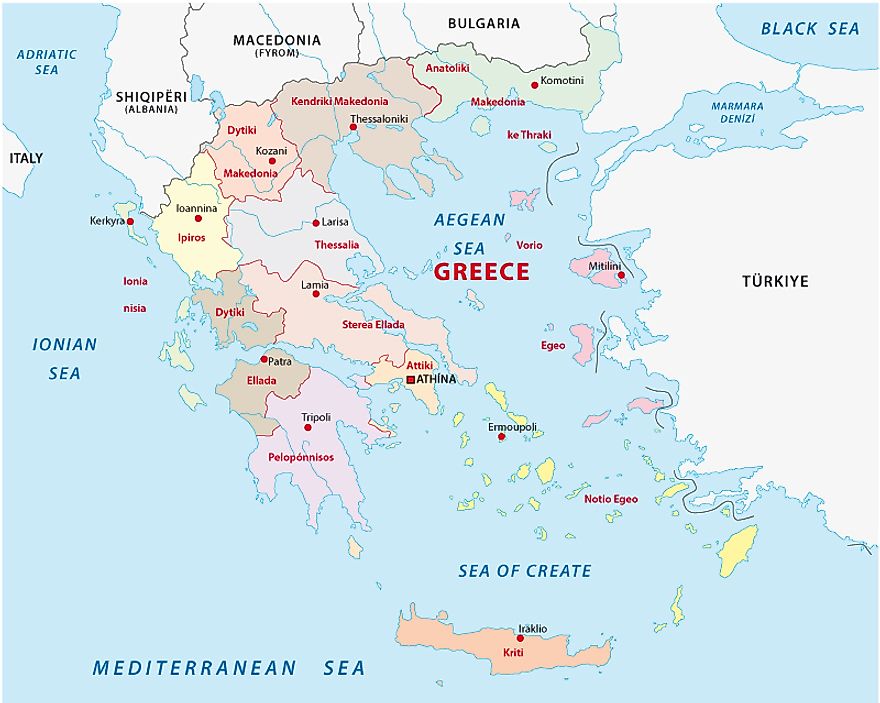The 13 Regions of Greece

Greece is a a country in southern Europe. Geographically, Greece is at the crossroads of Africa, Asia, and Europe. Greece is bordered by Turkey, Bulgaria, North Macedonia, Albania, Mediterranean Sea, Cretan Sea, Ionian Sea, and the Aegean Sea. Greece occupies an area of about 50,949 sq miles and had a population of approximately 10.7 million in 2018. Greece has the eleventh longest shoreline on the planet at 8,498 miles that includes numerous islands of which 227 islands are inhabited.
Greek Regions by Population
Attica
Attica is the most populous Greece administrative region that includes the entire Athens metropolitan area. Attica is situated on the eastern parts of Central Greece, and it occupies an area of about 1,470.32 sq miles. Other than Athens, Attica also includes Marathon, Laurium, Megara, Eleusis, and parts of the Peloponnese peninsula. Attica also includes various islands like Antikythera, Kythira, Spetses, Hydra, Poros, Angistri, Aegina, and Salamis islands. Attica has a population of about 3,750,000 people. Over 95% of the inhabitants of the region live in the Athens metropolitan area. Attica was established in 1987, and it’s currently subdivided into 8 subordinate regional units including South Athens, Central Athens, North Athens, and East Attica among others.
Central Macedonia
Central Macedonia is the second most-populous region in Greece with a population of about 1,874,590 people. The Central Macedonia Region was established by the Greece administrative reform of 1987. The region’s authority and powers were extended and redefined with the Kallikratis plan of 2010. Central Macedonia is split into 7 regional units with Thessaloniki being its capital city. Central
Thessaly
Thessaly is a Modern Greek administrative region that was initially known as Aeolia. Thessaly is the third most highly populated Greek region that has a population of about 730,730 people and an area of approximately 5,419.28 sq miles. Thessaly became a Greek state in 1881, after being under the Ottoman rule for over four centuries. Thessaly became one of the 13 administrative regions of Greece in 1987, and it is split into five regional units. Thessaly is situated in northern Greece, and it is surrounded by the Aegean Sea, Central Greece, Epirus, and Macedonia.
Western Greece
Western Greece is based at Patras and split into three regional units (Elis, Achaea, and Aetolia-Acamania). Western Greece is composed of northwestern parts of Peloponnesus and western parts of continental Greece. Western Greece is the fourth populous Greek region with a population of over 680,190 people.
Largest Regions by Area
Central Macedonia is the largest region in Greece which occupies an area of about 7,262 sq miles and the second-most populous. Central Greece is the second largest region in the country which occupies an area of about 6,003.62sq miles and ninth most populous. Central Greece is based at Lamia and is split into five regional units (Phthiotis, Phocis, Evrytania, Euboea, and Boeotia).
The 13 Regions of Greece
| Rank | Region | Population | Capital |
|---|---|---|---|
| 1 | Attica | 3,812,330 | Athens |
| 2 | Central Macedonia | 1,874,590 | Thessaloniki |
| 3 | Thessaly | 730,730 | Larissa |
| 4 | Western Greece | 680,190 | Patras |
| 5 | Crete | 621,340 | Heraklion |
| 6 | Eastern Macedonia and Thrace | 606,170 | Komotini |
| 7 | Peloponnese | 581,980 | Tripoli |
| 8 | Central Greece | 546,870 | Lamia |
| 9 | Epirus | 336,650 | Ioannina |
| 10 | South Aegean | 308,610 | Ermoupoli |
| 11 | Western Macedonia | 282,120 | Kozani |
| 12 | Ionian Islands | 206,470 | Corfu |
| 13 | North Aegean | 197,810 | Mytilene |











